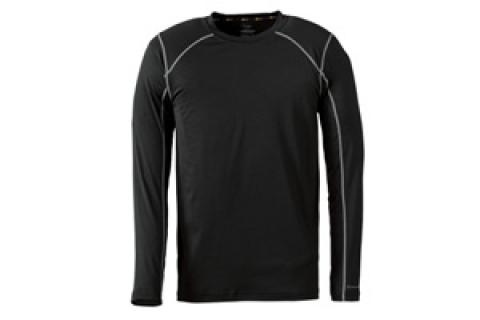
As a retired licensed hiking guide for the Department of Environmental Conservation and a volunteer Hike Coach for the Leukemia/Lymphoma Society for many years, I taught trail safety, and particularly how to be comfortable on the trail and get the most out of your outdoor experience.
 |
| Baselayers that have moisture-wicking capabilities is an important item to have when in the outdoors. |
Wearing the right clothing for your comfort is essential. Whether you're hiking, hunting or fishing, your body is constantly adjusting for changes in the temperature and humidity. Some days you'll sweat more than others; yet, on other days you won't even break a bead. Still, you're losing moisture all the time, and you're dehydrating whether you're wiping your brow off or not. So how you dress affects your level of comfort outside. With the diversity of fabrics to choose from these days, you are more prepared than ever before to protect yourself against the swings in weather conditions and temperatures.
Regardless of your sport, leave the cotton home. Unblended cotton, that is 100 percent cotton, while still a fabric of choice by many for casual wear, has no real place for the outdoors anymore. Cotton has no wicking features, per se, and it stays wet longer, which translates into getting a chill and maybe not warming up again. With brands such as RedHead, Under Armour and Columbia, the textile industry today offers a wide range of synthetic blends with great features and benefits in clothing for all outdoor activities.
Synthetic fabrics have various "blends" of cotton and polyester, and some are even 100 percent polyester. And each manufacturer has their own patents on fabric technology, too; such as Columbia's patent that includes a polymer technology in their fabric that helps lower body temperature, in addition to wicking away perspiration. In fact, for the tropic and sub-tropic anglers, Columbia's technologists even suggest layering for heat. Yes, even during the high temperatures of the tropics. Layering, using their tactical applications, lowers dehydration and lowers your body temperature.
Many other manufacturers, too, such at Under Armour, also include some UPF value for sun protection; and some even include an insect repellent formula, too. But all of them have some variation of a polyester blend that includes a wicking capability, cooling features, sun protection and insect repellent capability. The fabrics of today are so innovative with built-in features and benefits it makes your outdoor experience the best it can be. You know your body better than anybody else, so read the manufacturer's labels to find the fabric and style best suited for you
One last note. Many of the manufacturers embed an insect repellent element into their clothing. In the southeast we have a tendency to fish and hunt in warmer temperatures. With the right fabrics, these special features allow us to adjust our comfort level accordingly. In the deep woods, however, the strength of those built-in repellents is limited. They are not strong enough to keep the really bad things away, like ticks and chiggers. DEET, as controversial as it is, is still one of the best repellents against those critters. As long as you take a really thorough shower after returning from the woods, it doesn't have time to enter your system. With that said, products like REPEL 100, used liberally on your legs, arms, neck and torso, combined with the REPEL Sportsmen 40 percent DEET, sprayed on your clothing, will give you the ultimate layer of protection.
- 2976 views

